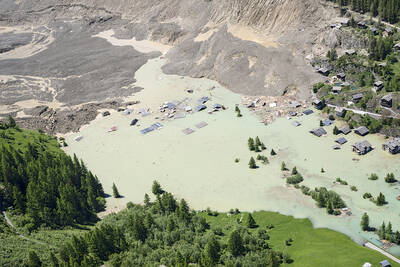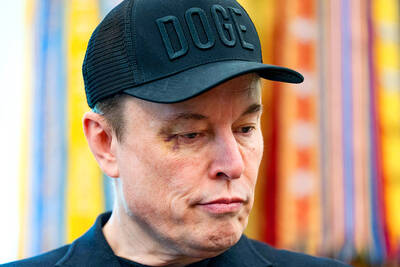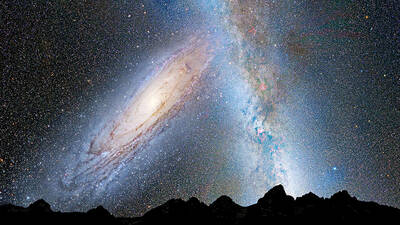A Japanese town yesterday set up a large mesh barrier at a popular viewing spot for Mount Fuji, in an attempt to discourage photograph-taking by an ever-growing number of tourists.
Japan’s most famous sight can be seen for kilometers, but Fujikawaguchiko locals are fed up with streams of mostly foreign visitors littering, trespassing and breaking traffic rules in their hunt for a photo to share on social media.
Parking illegally and ignoring a smoking ban, they would cram a pavement to shoot the snow-capped mountain, which soars photogenically into the sky from behind a Lawson convenience store, residents said.

Photo: AFP
Workers began putting the black netting measuring 2.5m by 20m in place yesterday, and by late morning they were already done, a reporter at the scene said.
“I hope that the net will prevent dangerous activities,” said Michie Motomochi, 41, who runs a traditional Japanese sweet shop.
“I think it’s disappointing that they are putting it up. It’s obviously an iconic shot, but it’s completely understandable,” said Christina Roys, 36, a tourist from New Zealand.
“We were here last night, managing to get the last shot before they were putting up the wall, and there were so many people,” she said. “It’s quite dangerous because of the traffic coming through. There are other spots where you can get the shot of the mountain.”
Record numbers of overseas tourists are visiting Japan, where monthly visitors exceeded 3 million for the first time in March and then again last month.
However, as in other tourist hotspots, such as Venice — which recently launched a trial of entry fees for day visitors — the influx has not been universally welcomed.
In Japan’s ancient capital of Kyoto, locals have complained of tourists harassing the city’s famed geisha, and hikers using the most popular route to climb Mount Fuji this summer are to be charged ¥2,000 (US$13) each, with entries capped at 4,000 to ease congestion.
A new online booking system for the mountain’s Yoshida trail opened on Monday to guarantee hikers entry through a new gate, although 1,000 places a day are to be kept for day-of entries.
Mount Fuji is covered in snow most of the year, but during the July-to-September hiking season, more than 220,000 visitors trudge up its steep, rocky slopes.
Many climb through the night to see the sunrise, and some attempt to reach the 3,776m summit without breaks, becoming sick or injured as a result.
Regional officials have raised safety and environmental concerns linked to overcrowding on the active volcano, a symbol of Japan and a once-peaceful pilgrimage site.
Residents near other popular photo spots in the region, including the so-called Fuji Dream Bridge, have also reportedly complained about overtourism in the past few weeks.
One tour operator that offers day trips from Tokyo to the Mount Fuji area said they are taking visitors to another Lawson store nearby where a similar view can be seen, but there are fewer nearby residents.

The collapse of the Swiss Birch glacier serves as a chilling warning of the escalating dangers faced by communities worldwide living under the shadow of fragile ice, particularly in Asia, experts said. Footage of the collapse on Wednesday showed a huge cloud of ice and rubble hurtling down the mountainside into the hamlet of Blatten. Swiss Development Cooperation disaster risk reduction adviser Ali Neumann said that while the role of climate change in the case of Blatten “still needs to be investigated,” the wider impacts were clear on the cryosphere — the part of the world covered by frozen water. “Climate change and

Poland is set to hold a presidential runoff election today between two candidates offering starkly different visions for the country’s future. The winner would succeed Polish President Andrzej Duda, a conservative who is finishing his second and final term. The outcome would determine whether Poland embraces a nationalist populist trajectory or pivots more fully toward liberal, pro-European policies. An exit poll by Ipsos would be released when polls close today at 9pm local time, with a margin of error of plus or minus 2 percentage points. Final results are expected tomorrow. Whoever wins can be expected to either help or hinder the

DENIAL: Musk said that the ‘New York Times was lying their ass off,’ after it reported he used so much drugs that he developed bladder problems Elon Musk on Saturday denied a report that he used ketamine and other drugs extensively last year on the US presidential campaign trail. The New York Times on Friday reported that the billionaire adviser to US President Donald Trump used so much ketamine, a powerful anesthetic, that he developed bladder problems. The newspaper said the world’s richest person also took ecstasy and mushrooms, and traveled with a pill box last year, adding that it was not known whether Musk also took drugs while heading the so-called US Department of Government Efficiency (DOGE) after Trump took power in January. In a

It turns out that looming collision between our Milky Way and Andromeda galaxies might not happen after all. Astronomers on Monday said that the probability of the two spiral galaxies colliding is less than previously thought, with a 50-50 chance within the next 10 billion years. That is essentially a coin flip, but still better odds than previous estimates and farther out in time. “As it stands, proclamations of the impending demise of our galaxy seem greatly exaggerated,” the Finnish-led team wrote in a study appearing in Nature Astronomy. While good news for the Milky Way galaxy, the latest forecast might be moot